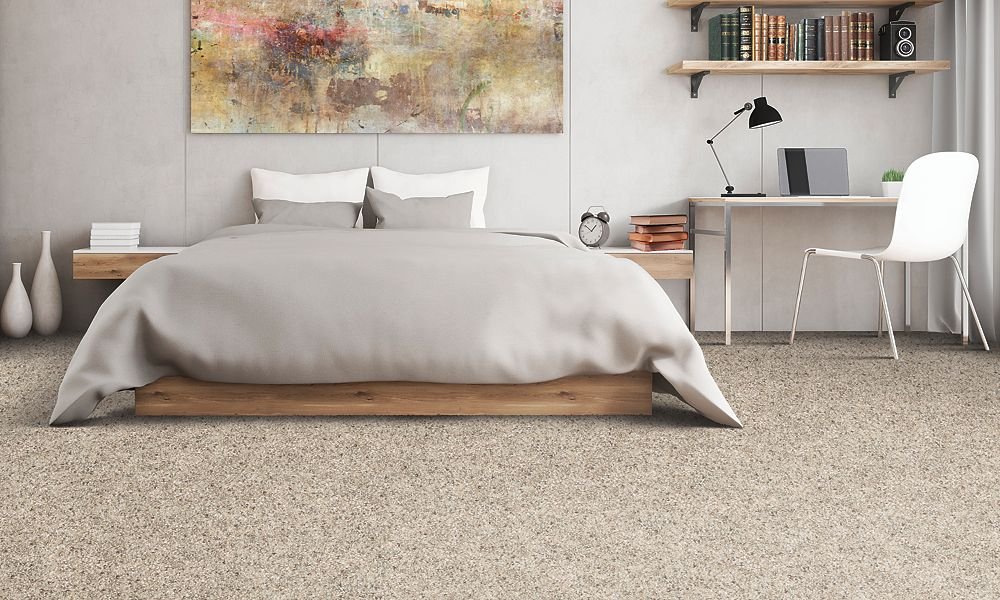CARPET
FLOORING
Carpet flooring stands out for its soft texture, warmth, and ability to absorb sound, making it perfect for creating comfortable, quiet spaces. Its versatility allows it to enhance spaces like bedrooms and offices. But there's more to carpet than comfort—let's explore what makes it such a timeless flooring choice.
What is Carpet Flooring Made From?
Carpet flooring is made from both natural and synthetic fibres, such as wool, nylon, polyester, and olefin. These fibres are woven or tufted into a backing material, creating a surface that's soft underfoot while being durable enough to handle everyday use.
Carpet flooring is popular in residential and commercial spaces because it offers excellent insulation, cushioning, and visual appeal. Available in various styles to suit any taste, carpets provide comfort and versatility. With proper maintenance, they can remain a durable and attractive flooring option for many years.
Types of Carpet Floors
There are two main types of carpet flooring: broadloom carpet and carpet tiles.
Carpet Tiles
Carpet tiles, also known as carpet squares, come in sizes like 18 inches by 18 inches or 24 inches by 24 inches. These individual tiles provide flexibility in design and installation, allowing for various patterns and easy replacement of damaged tiles.
Their durability and ease of maintenance make them suitable for commercial settings and high-traffic areas. They also offer the added advantage of quick and easy tile replacement.
Broadloom Carpet
Broadloom carpet, a wall-to-wall flooring, is produced in large continuous rolls, typically 12 to 15 feet wide. This design provides seamless coverage throughout the room, creating a unified look.
With various styles, patterns, and materials available, broadloom carpet is ideal for residential spaces like bedrooms and living rooms and commercial environments such as offices, hotels, and retail stores.
Types of Carpet Construction
Carpet construction refers to the method used to create the carpet’s pile and backing, affecting its durability, texture, and appearance. Some include:
Cut Pile Carpet
Cut pile carpet involves cutting the yarn loops to create a soft, plush surface. This method results in a dense, luxurious texture perfect for areas where comfort is key, such as living rooms and hallways.
Cut pile carpets are known for their exceptional softness and come in various styles. For instance, plush carpets offer a smooth and even surface for a classic look, while frieze carpets feature long, twisted fibres that provide a more casual appearance. Textured cut pile carpets use unevenly cut fibres to create a relaxed look and help mask footprints and vacuum marks.
Loop Pile Carpet
Loop pile carpet is created by weaving loops of yarn into the backing and leaving them uncut. This results in a textured surface that is durable and resistant to crushing, making it ideal for high-traffic areas. The looped design provides a distinct texture and can conceal dirt and stains.
There are two main types of loop pile carpets: level loop, where all loops are of the same height for a consistent look, and multi-level loop, which features varying loop heights to create a more dynamic texture. Both types offer durability and style, fitting a range of design preferences and functional needs.
Cut & Loop Pile Carpet
Cut-and-loop carpet combines elements of cut-pile and loop-pile constructions to create a unique and textured surface. Combining cut and looped fibres creates patterns and textures that can add depth and dimension to a room.
Cut-and-loop carpets are particularly effective at hiding dirt and footprints, making them a practical choice for busy areas.
Pros of Carpet Flooring
Ease of Installation: Designed for simple installation, often without stretching, making it convenient.
Sound Absorption: The dense fibres help reduce noise, creating a quieter environment.
Adaptability: Carpet tiles are perfect for various spaces and layouts, with their modular design allowing easy fitting.
Cost-Effectiveness: It is a budget-friendly flooring solution. Broadloom carpets are economical for large areas, while carpet tiles allow easy and affordable replacements.
Comfort: It offers a soft, cushioned surface that adds warmth and coziness, especially in colder months.
Sound Absorption: Its dense fibres help absorb sound, reduce noise, and create a quieter environment.
Cons of Carpet Flooring
Maintenance: Regular vacuuming and occasional deep cleaning are necessary to keep carpets free from dirt, stains, and dust.
Allergen Trapping: Carpets can trap allergens like dust mites, pet dander, and pollen, which may worsen allergies or respiratory conditions.
Moisture Absorption: Carpet fibres can absorb moisture, potentially leading to mould, mildew, and unpleasant odours.
Durability: While carpet tiles are resilient, they may not hold up as well under heavy foot traffic compared to other flooring types.
Tile Adhesion: The adhesive for carpet tiles can weaken over time, possibly causing tiles to shift or come loose.
Maintenance of Carpet Flooring
Regular Vacuuming: Vacuum your carpets regularly to remove dirt, dust, and debris. A vacuum cleaner with a rotating brush or beater bar helps to loosen and lift dirt from the carpet fibres.
Deep Cleaning: Perform occasional deep cleaning using a carpet cleaner or hire a professional service to remove embedded stains and ground-in dirt.
Spot Cleaning: Address spills and stains promptly using appropriate carpet cleaners to prevent them from setting.
Avoid Excess Moisture: Ensure carpets are not exposed to excessive moisture, which can lead to mould and mildew. Clean up spills quickly.
Rotate Carpet Furniture: Periodically rotate furniture to prevent permanent indentations in the carpet and more evenly distributed wear.
Carpet adds the warmth and comfort your home or office needs. If you're looking for that extra touch, our team is here to help. Contact us today to get started!






